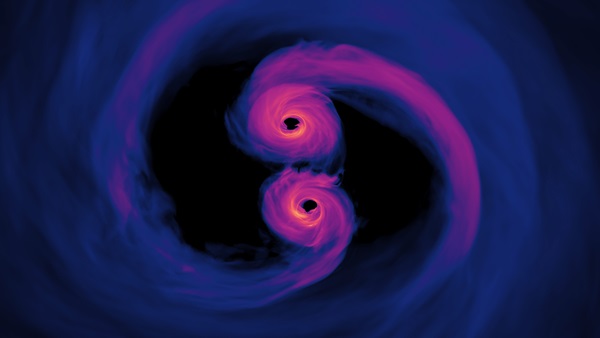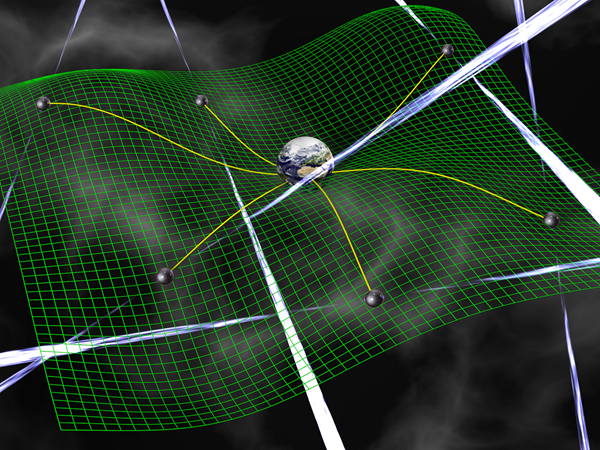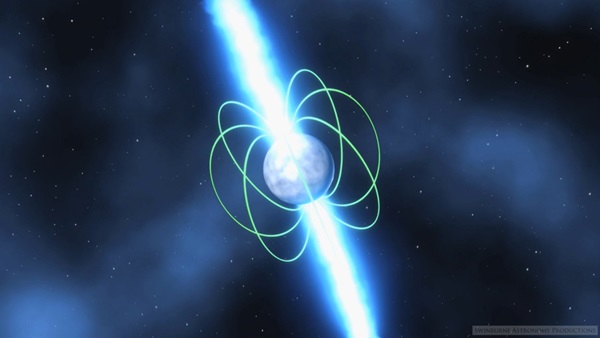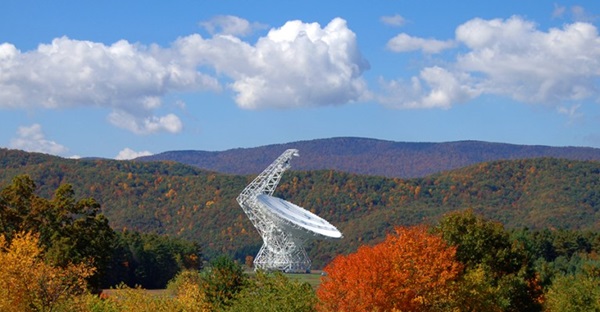Key Takeaways:
Astronomers have found the strongest evidence yet for a predicted-yet-undetected class of gravitational waves created by supermassive black holes in the cores of galaxies. And they think they could have a firm detection within a couple of years.
Gravitational waves have become one of the hottest topics in astronomy. It started some five years ago, when the LIGO and Virgo collaborations announced the very first detection of gravitational waves, which were produced by a collision of stellar-mass black holes that distorted space-time itself, sending ripples through the fabric of the cosmos.
But gravitational waves aren’t created only by cataclysmic, short-lived events. For instance, pairs of supermassive black holes lurking in the centers of some galaxies should also etch long-wavelength gravitional waves into space-time as they spiral toward each other. While the main bursts of short-wavelength gravitational waves from star-sized black hole collisions wash over Earth in a fraction of a second, a single wave from a duo of dancing supermassive black holes may take decades to pass us by. In fact, general relativity predicts that Earth is constantly awash in low-frequency/long-wavelength gravitational waves like these, bobbing like a buoy at sea as it rides swells coming from every direction.
In a paper published last month in The Astrophysical Journal Letters, a team reported the strongest evidence yet for this background sea of gravitational waves. The researchers are part of the North American Nanohertz Observatory for Gravitational Waves (NANOGrav), a project that relies on data from the Green Bank Telescope and the now-defunct Arecibo Observatory. These massive radio telescopes observe pulsars — highly magnetic, spinning compact stars that emit beams of radio waves and rotate at hundreds of times per second. The basic premise of NANOGrav is that gravitational waves should disturb the otherwise clockwork-like pulses of pulsars. And the researchers think they’re starting to see exactly that.
Even though the new study does not claim a clear detection of gravitational waves, it’s still “a mic drop moment,” says Kelly Holley-Bockelmann, an astronomer at Vanderbilt University, who wasn’t involved in the work. “Humanity may have just heard the background rumble of the most extreme black holes in the universe.”
Spacetime sea
Previous detections of gravitational waves have come from instruments like the Laser Interferometer Gravitational-Wave Observatory (LIGO), which uses mirrors spaced 2.5 miles (4 kilometers) apart that reflect laser beams. As a short-wavelength gravitational wave washes over the giant instrument, the resulting distortion in space-time changes the apparent length of its beam by roughly 1/10,000 the diameter of a proton. And LIGO can detect that change.
So, to observe gravitational waves with longer wavelengths, astronomers have effectively created a galaxy-sized detector by tracking the radio signals from pulsars scattered across the Milky Way. If the space-time around Earth is stretched or compressed, the signals from pulsars should arrive slightly early or late. Furthermore, these timing variations should be correlated in a pattern characteristic of a gravitational wave, not simply random.
After tracking the timing of 47 pulsars — some since 2004 — the NANOGrav team is confident they’ve found the first piece of the puzzle: They discovered that pulsar timings can vary by up to hundreds of nanoseconds. “We are seeing incredibly significant evidence for this signal,” said NANOGrav team member Joseph Simon of the University of Colorado Boulder on Monday at an online press conference at the 2021 winter meeting of the American Astronomical Society.
Their dataset doesn’t yet show that that those variations are correlated, which means the team isn’t yet claiming a detection of gravitational waves. However, they have been able to eliminate alternative explanations for the variations, like uncertainty in the solar system’s center of mass and interference from interstellar dust.
Many astronomers think NANOGrav is on the right track, too. “The team has made meticulous observations and done some really compelling statistical analysis, so I’m convinced they’re seeing something unusual,” says Holley-Bockelmann. “I wouldn’t bet my house that it’s gravitational waves, but I would bet a very nice bottle of wine.”
The fact that the evidence is not yet completely clear isn’t too surprising, says Caltech astronomer and LIGO researcher Alan Weinstein. LIGO, he says, was “amazingly lucky — the very first signal was loud, clear, certain, and spectacular. … We expected that the first evidence would come in weakly, with uncertainty, and this is quite possibly what NANOGrav is starting to see.”
More evidence should follow from similar projects, like the Parkes Pulsar Timing Array (PPTA) in Australia, which began around the same time as NANOGrav. George Hobbs of the Commonwealth Scientific and Industrial Research Organisation (CSIRO), who leads the project, says that PPTA will present an analysis of its observations “sometime soon” with similar results.
“The NANOGrav result is much more convincing than many of the false alarms that we’ve had in the past,” he says. Still, Hobbs cautions against jumping to conclusions. “I’ve now had around 15 years of people saying, ‘Hey, we’ve found gravitational waves in our data,’ and so we need to be enthusiastic and cautious at the same time.”
Seeking confirmation
Luckily, NANOGrav already has roughly 2.5 years of additional data from both Green Bank and Arecibo — with the latter observing pulsars right up until Arecibo went offline after a cable failure in August 2020, which eventually led to the telescope’s total collapse in December.
The loss of Arecibo was a huge blow to NANOGrav, but the team’s simulations suggest that the data they already have should be enough to reveal the timing correlations between pulsars, if they exist. But now they need to analyze it, which the team hopes to complete within the next two years, says Scott Ransom, the project’s chair and a researcher at the National Radio Astronomy Observatory.
If they succeed in making a detection, it would open up an entirely new area of the gravitational wave spectrum for study. “NANOGrav and LIGO complement each other wonderfully,” says Weinstein. “If you compare with electromagnetic (light) observations, NANOGrav is like radio astronomy, while LIGO is like optical astronomy. They ‘see’ different sources.”
In the case of binary supermassive black holes, astronomers hope gravitational waves will clarify the physics of how they evolve, perhaps resolving the “final parsec problem” — the inability of theoretical models to get pairs of black holes to lose enough orbital energy to close the last few light-years of distance between them.
In anticipation of such studies, and in light of Arecibo’s demise, astronomers are already preparing to scale up pulsar timing array operations. NANOGrav and PPTA are partners in the International Pulsar Timing Array (IPTA) — an attempt to combine observations from telescopes around the world, including a European array and China’s Five-hundred-meter Aperture Spherical radio Telescope, the single largest radio dish in the world. Ransom also says NANOGrav is in “a huge amount of negotiations” with the Green Bank Observatory and its owner, the National Science Foundation, to secure more time, partially making up for the loss of Arecibo.
Arecibo’s collapse has also increased the urgency of getting the IPTA up and running. But it’s a painstaking task to perform analyses that combine data from that many different telescopes, each of which has their own instrumental idiosyncrasies. “They really are much more complicated, they take a lot more time, and we truly haven’t had the money to have personnel dedicated to work on those,” says Ransom.
“That’s a problem.” But, he adds, “if we can get the IPTA to work correctly, we are automatically about roughly a factor of two more sensitive than any individual pulsar timing array, which is huge.”













